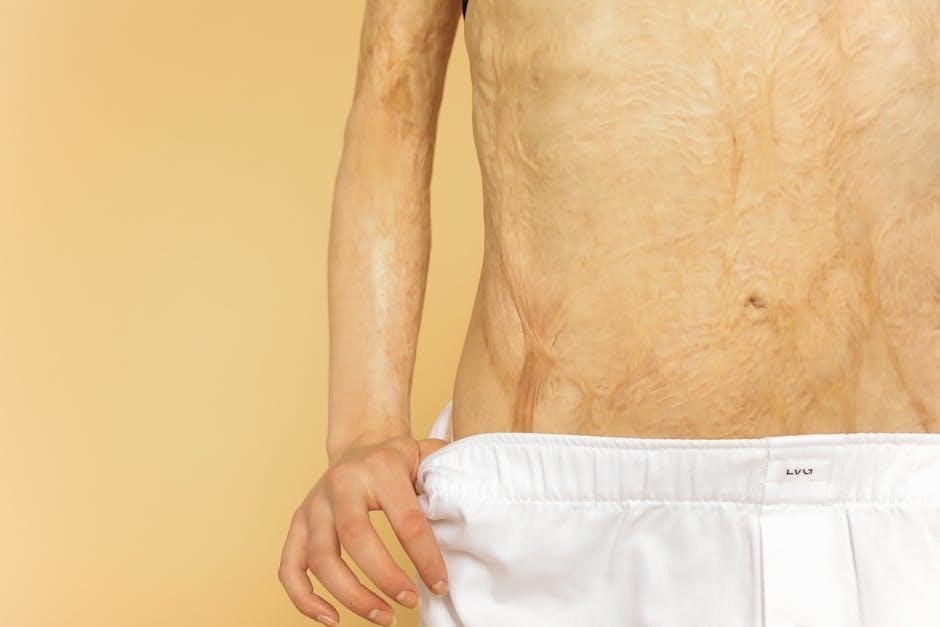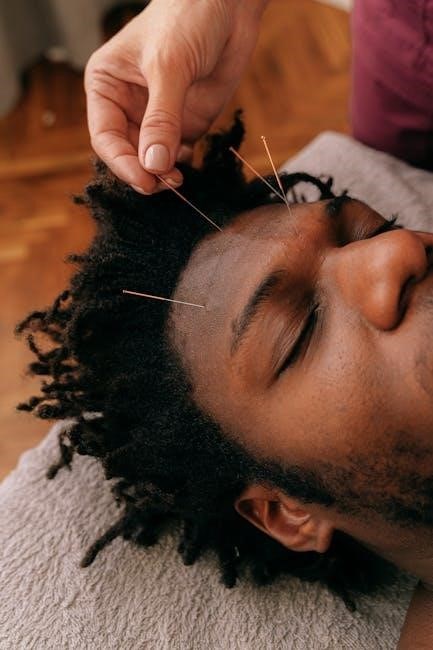Double Crush Syndrome involves nerve compression at two or more locations, disrupting axoplasmic flow and exacerbating symptoms․ First proposed in 1973, it highlights the importance of addressing multiple compressions in physical therapy treatment to restore nerve function and alleviate pain․
1․1 Definition and Overview of Double Crush Syndrome
Double Crush Syndrome (DCS) is a condition where a nerve is compressed at two or more distinct locations along its path․ This dual compression disrupts axoplasmic flow, making the nerve more susceptible to injury․ Initially proposed in 1973, DCS is often seen in the upper extremities, where nerves like the median, ulnar, and radial nerves are commonly affected․ It frequently co-occurs with conditions such as carpal tunnel syndrome, cubital tunnel syndrome, and cervical radiculopathy․ The syndrome is crucial in physical therapy as it requires addressing all compression sites to restore nerve function and relieve symptoms effectively․ Accurate diagnosis and targeted interventions are essential for optimal outcomes․
1․2 Historical Background and Importance in Physical Therapy
The concept of Double Crush Syndrome (DCS) was first introduced in 1973, highlighting the impact of multiple nerve compressions on axonal function․ This theory gained traction with studies by Massey in 1981, demonstrating coexistence of cervical radiculopathy and carpal tunnel syndrome․ In physical therapy, recognizing DCS is vital as it necessitates a comprehensive approach addressing all compression points․ Traditional treatments focusing on single-site interventions often fail to alleviate symptoms fully, emphasizing the need for multifaceted therapies․ Early detection and tailored interventions significantly improve patient outcomes, making DCS a critical area of focus in physical therapy practice and research․ Understanding its historical development underscores its relevance in modern rehabilitation strategies․
Pathophysiology of Double Crush Syndrome
Double Crush Syndrome occurs when nerve compression at two or more sites disrupts axoplasmic flow, increasing susceptibility to further injury and impairing nerve function․
In Double Crush Syndrome, nerve compression at multiple sites disrupts axoplasmic flow, impairing the transport of essential nutrients and proteins necessary for nerve function․ This disruption leads to nerve ischemia, inflammation, and demyelination, exacerbating symptoms like numbness, tingling, and weakness․ The compression at one site increases vulnerability to damage at another, creating a cumulative effect․ This pathophysiological process highlights the importance of addressing all compression points in physical therapy to restore proper nerve function and prevent further deterioration․ Understanding this mechanism is crucial for effective treatment strategies in managing the condition․ Double Crush Syndrome often involves nerve entrapments at multiple sites along the upper extremities, disrupting nerve function and exacerbating symptoms like pain, numbness, and weakness․ Cervical radiculopathy involves compression or irritation of nerve roots in the cervical spine, often leading to pain, numbness, and weakness in the neck and upper extremities․ This condition frequently coexists with distal nerve entrapments, contributing to Double Crush Syndrome․ Compression at the cervical level disrupts axoplasmic flow, making nerves more susceptible to injury at other locations․ Massey’s 1981 study highlighted the association between cervical radiculopathy and carpal tunnel syndrome, emphasizing the importance of addressing both proximal and distal compressions․ Physical therapy plays a critical role in managing cervical radiculopathy through exercises targeting cervical mobility, strength, and nerve mobilization․ Accurate diagnosis and treatment are essential to prevent further nerve damage and restore functional abilities․ Carpal Tunnel Syndrome (CTS) arises from median nerve compression within the carpal tunnel at the wrist․ Symptoms include numbness, tingling, and weakness in the thumb and first three fingers․ CTS often coexists with cervical radiculopathy, contributing to Double Crush Syndrome․ This dual compression exacerbates nerve dysfunction, as impaired axoplasmic flow from cervical compression makes the median nerve more susceptible to injury at the wrist․ Physical therapy for CTS focuses on wrist mobilization, nerve gliding exercises, and ergonomic modifications to reduce repetitive strain․ Early intervention is crucial to prevent long-term nerve damage and restore hand function, addressing both proximal and distal compressions effectively․ Cubital Tunnel Syndrome occurs due to compression of the ulnar nerve at the elbow, often near the cubital tunnel․ Symptoms include numbness, tingling, and weakness in the little and ring fingers․ This condition frequently coexists with Thoracic Outlet Syndrome (TOS), contributing to Double Crush Syndrome․ Cyclists are particularly prone to this combination due to repetitive elbow flexion and shoulder postures․ Compression at both the elbow and shoulder regions disrupts nerve function, worsening symptoms․ Physical therapy focuses on ulnar nerve mobilization, elbow flexor stretching, and ergonomic adjustments to reduce strain․ Addressing both sites of compression is essential for effective treatment and recovery, ensuring full restoration of nerve function and hand dexterity․ Thoracic Outlet Syndrome (TOS) involves compression of the brachial plexus or subclavian vessels between the first rib, clavicle, and scalene muscles․ Symptoms include pain, numbness, and weakness in the neck, shoulder, and upper extremity․ TOS often coexists with other nerve entrapments, such as carpal tunnel syndrome, contributing to Double Crush Syndrome․ Activities involving repetitive overhead motions, poor posture, or prolonged driving can exacerbate TOS․ Cyclists and individuals with jobs requiring heavy lifting are at higher risk․ Physical therapy focuses on improving thoracic and cervical mobility, strengthening shoulder muscles, and addressing ergonomic factors․ Addressing TOS is critical in managing Double Crush Syndrome, as untreated compression can worsen symptoms and hinder recovery․ Early intervention is key to restoring function and reducing pain․ Patients with Double Crush Syndrome often experience numbness, tingling, and pain in the neck, shoulder, or upper extremity․ Symptoms may worsen with specific activities․ Cervical radiculopathy typically presents with sharp, shooting pain radiating from the neck to the shoulder or arm․ Patients may experience numbness, tingling, or weakness in the affected dermatome․ Activities such as neck movement or coughing often exacerbate symptoms․ In severe cases, muscle atrophy or diminished reflexes can occur․ Proper diagnosis and treatment are essential to prevent further nerve damage and improve functional outcomes․ Physical therapy plays a crucial role in managing these symptoms through targeted exercises and manual therapy techniques․ Early intervention can significantly enhance recovery and reduce the risk of chronic pain or disability․ Carpal Tunnel Syndrome (CTS) primarily affects the median nerve, causing numbness, tingling, and pain in the wrist and hand․ Symptoms often worsen at night or with repetitive activities․ Patients may experience a “pins and needles” sensation in the thumb, index, and middle fingers․ Weakness in grip strength and difficulty performing fine motor tasks are common․ In severe cases, atrophy of the thenar muscles can occur․ These symptoms can significantly impact daily activities and work performance․ Early identification and intervention are crucial to prevent progression and improve functional outcomes․ Physical therapy plays a key role in managing CTS symptoms through exercises and modalities tailored to restore nerve function and reduce discomfort․ Prompt treatment can enhance recovery and reduce the risk of long-term disability․ Cubital Tunnel Syndrome involves compression of the ulnar nerve at the elbow, leading to pain, numbness, and tingling in the elbow and hand․ Symptoms often radiate to the little and ring fingers, causing discomfort during activities like gripping or bending the elbow․ Prolonged pressure on the elbow, such as leaning on it for extended periods, can exacerbate symptoms․ Weakness in hand muscles may develop, affecting grip strength and dexterity․ In severe cases, muscle wasting or atrophy of the hand muscles can occur․ Early identification and intervention are critical to prevent long-term nerve damage and restore functional ability․ Physical therapy plays a key role in managing these symptoms, focusing on nerve mobilization and strengthening exercises to alleviate discomfort and improve mobility․ Proper treatment can significantly enhance recovery and reduce the risk of chronic disability․ Thoracic Outlet Syndrome (TOS) occurs due to compression of the brachial plexus and/or subclavian vessels in the thoracic outlet․ Common symptoms include pain and numbness in the neck, shoulder, and arm, often radiating to the hand․ Patients may experience tingling or weakness, particularly in the fourth and fifth fingers․ Activities such as overhead reaching or prolonged sitting can exacerbate symptoms․ Compression of the subclavian artery or vein may cause circulatory issues, such as coolness or discoloration of the affected limb․ In severe cases, muscle wasting or diminished reflexes may occur․ Early diagnosis and intervention are crucial to prevent long-term damage․ Physical therapy plays a key role in addressing TOS by focusing on posture correction, nerve mobilization, and strengthening exercises to alleviate symptoms and restore function․ Prompt treatment can significantly improve outcomes and reduce the risk of chronic disability․ Diagnosis involves a combination of physical examination, imaging studies, and electrodiagnostic testing to identify multiple nerve compressions․ Accurate assessment ensures targeted physical therapy interventions for optimal recovery․
Physical examination techniques for diagnosing Double Crush Syndrome include neurological assessments, manual muscle testing, and specific nerve tension tests․ These methods help identify multiple compression sites․ Imaging studies and diagnostic tests are crucial for confirming nerve compression sites in Double Crush Syndrome․ MRI and CT scans are commonly used to visualize nerve structures and identify compressions․ X-rays may also be employed to rule out fractures or arthritis affecting nerve pathways․ Electrodiagnostic tests, such as electromyography (EMG), assess nerve function and detect damage․ These tools help pinpoint the exact locations of nerve entrapment, guiding targeted physical therapy interventions․ A combination of imaging and electrodiagnostic testing ensures a comprehensive diagnosis, enabling effective treatment plans tailored to address multiple compression points․ These tests are essential for confirming the presence of Double Crush Syndrome and informing therapeutic strategies․ Electrodiagnostic testing, including electromyography (EMG) and nerve conduction studies (NCS), plays a pivotal role in diagnosing Double Crush Syndrome․ EMG measures the electrical activity of muscles to identify nerve damage or dysfunction, while NCS assesses nerve function by evaluating signal speed and strength․ These tests help pinpoint the exact locations of nerve compression and determine the extent of axonal damage․ By analyzing muscle activity and nerve conduction, healthcare providers can differentiate between single and double compressions․ Abnormal results, such as slowed nerve conduction velocities or reduced amplitudes, are indicative of nerve entrapment․ These findings are critical for confirming the diagnosis and guiding targeted physical therapy interventions․ EMG/NCS provides objective data, enhancing the accuracy of treatment plans for Double Crush Syndrome․ Physical therapy for Double Crush Syndrome includes nerve mobilization, manual therapy, modalities, and patient education to restore nerve mobility and reduce symptoms effectively․ Therapeutic exercises for nerve mobilization are essential in managing Double Crush Syndrome, focusing on improving nerve glide and reducing tension․ These exercises target specific nerves, such as the median, ulnar, and radial nerves, to enhance mobility and reduce compression․ Techniques include tensile loading exercises, nerve gliding, and sliding exercises to promote axoplasmic flow․ For example, neck flexion with arm extension can address cervical radiculopathy, while wrist and elbow movements help with carpal or cubital tunnel symptoms․ Gentle, repetitive motions are emphasized to avoid further irritation․ Progressing exercises gradually ensures optimal recovery․ Patient adherence to these exercises is crucial for restoring functional mobility and alleviating symptoms effectively․ Regular practice helps prevent recurrence and supports long-term recovery․ Manual therapy techniques play a vital role in treating Double Crush Syndrome by addressing nerve compression and improving joint mobility․ Techniques such as soft tissue mobilization, joint mobilization, and myofascial release are commonly used to reduce tension in affected areas․ For instance, cervical spine manipulation can alleviate cervical radiculopathy, while carpal tunnel mobilization targets median nerve compression․ Trigger point therapy is also effective in releasing tight muscles that may contribute to nerve entrapment․ Manual therapy not only enhances nerve glide but also improves blood flow to the affected regions, promoting healing and reducing inflammation․ These techniques, when combined with therapeutic exercises, offer a comprehensive approach to managing symptoms and restoring functional movement in patients with Double Crush Syndrome․ Regular sessions with a physical therapist ensure optimal outcomes and prevent further complications․ Physical therapy modalities are essential in managing Double Crush Syndrome, offering symptom relief and enhancing recovery․ Electrotherapy, such as TENS (Transcutaneous Electrical Nerve Stimulation), is widely used to reduce pain and inflammation by interrupting pain signals to the brain․ Ice and heat therapy are applied to reduce swelling and relax muscles, improving circulation to compressed nerves․ Ultrasound therapy promotes tissue healing by increasing blood flow and breaking down scar tissue․ These modalities are often combined with exercises and manual techniques to address both proximal and distal nerve compressions․ They provide immediate relief and support long-term recovery by addressing the underlying causes of nerve entrapment․ Regular use of these modalities in physical therapy helps restore nerve function and improves patient outcomes in Double Crush Syndrome․ Patient education is a cornerstone of physical therapy for Double Crush Syndrome, empowering individuals to manage symptoms and prevent further nerve compression․ Education focuses on proper posture, activity modification, and ergonomic adjustments to reduce strain on affected nerves․ For example, workplace adaptations, such as adjusting desk heights or using ergonomic tools, can minimize repetitive stress․ Patients are also taught exercises to strengthen muscles and improve flexibility, reducing nerve tension․ Additionally, lifestyle modifications, such as avoiding prolonged positions that exacerbate symptoms, are emphasized․ By addressing both physical and environmental factors, patient education and ergonomic changes play a critical role in enhancing recovery and preventing recurrence, making them integral to comprehensive physical therapy programs․ Double Crush Syndrome prevalence varies, often linked to repetitive occupational tasks, prolonged nerve compression, and age-related nerve sensitivity, commonly affecting individuals with pre-existing musculoskeletal conditions․ Double Crush Syndrome is more prevalent in specific demographic and occupational groups․ Individuals engaged in repetitive or prolonged activities, such as cyclists, are at higher risk due to nerve compression in multiple sites․ For instance, cyclists often experience ulnar neuropathy and thoracic outlet syndrome simultaneously․ Studies indicate that 42% of thoracic outlet syndrome cases and 41 out of 165 carpal tunnel syndrome cases involve double crush syndrome․ Occupations requiring repetitive hand movements, prolonged computer use, or vibrating tool operation also increase susceptibility․ Age and pre-existing musculoskeletal conditions further heighten the risk, as nerve sensitivity and degeneration become more common․ Understanding these factors aids in early identification and tailored physical therapy interventions to address both proximal and distal nerve compressions effectively․ Prognosis for Double Crush Syndrome improves with early diagnosis and comprehensive treatment addressing all compression sites․ Recovery depends on severity and effectiveness of physical therapy interventions․ Recovery and long-term outcomes in Double Crush Syndrome are influenced by the severity of nerve compression, promptness of diagnosis, and effectiveness of treatment․ Early intervention through physical therapy, addressing both proximal and distal compressions, significantly enhances prognosis․ Patient compliance with rehabilitation programs and ergonomic modifications also plays a crucial role․ Additionally, underlying health conditions and occupational factors can impact recovery․ Studies suggest that comprehensive treatment plans tailored to individual needs improve functional outcomes, reducing the risk of chronic pain and disability․ Long-term prognosis is favorable when all compression sites are adequately managed, emphasizing the importance of a multidisciplinary approach in patient care․ A 59-year-old male with right shoulder pain and paresthesia benefited from targeted physical therapy, improving mobility and reducing symptoms of double crush syndrome effectively․ A 59-year-old male with right shoulder pain and paresthesia experienced significant improvement through targeted physical therapy․ Interventions included nerve mobilization exercises, manual therapy, and ergonomic modifications․ Stretching and strengthening exercises addressed both proximal and distal nerve compression sites․ Modalities like ice and heat were used to reduce inflammation․ Regular reassessment ensured tailored adjustments to the treatment plan․ The patient reported reduced numbness, improved mobility, and enhanced ability to perform daily tasks․ This case highlights the effectiveness of comprehensive physical therapy in managing double crush syndrome by addressing multiple entrapment points and restoring nerve function․ Such interventions underscore the importance of individualized care in achieving optimal outcomes․ Double Crush Syndrome requires a comprehensive approach, addressing multiple nerve compressions․ Physical therapy plays a crucial role in managing symptoms and restoring function, emphasizing the need for individualized care․ Double Crush Syndrome management requires a multidisciplinary approach, integrating physical therapy, patient education, and ergonomic adjustments․ Current strategies focus on addressing both proximal and distal nerve compressions, improving axoplasmic flow, and reducing symptoms like numbness and pain․ Advances in diagnostic tools, such as electrodiagnostic testing, enhance early identification and targeted interventions․ Future directions include exploring personalized treatment plans, incorporating emerging technologies, and expanding research on long-term outcomes․ Collaboration between physical therapists, physicians, and patients is essential for optimizing recovery and preventing recurrence․ By prioritizing comprehensive care, the management of Double Crush Syndrome can evolve to improve quality of life for affected individuals․ Massey, E․W․ (1981)․ “Carpal Tunnel Syndrome and Cervical Radiculopathy: Double Crush Syndrome․” Journal of Neurology, Neurosurgery, and Psychiatry, 44(10), 926-928․2․1 Mechanism of Nerve Compression and Axoplasmic Flow Disruption
Common Upper Extremity Nerve Entrapments
3․1 Cervical Radiculopathy and Nerve Root Compression
3․2 Carpal Tunnel Syndrome and Median Nerve Compression
3․3 Cubital Tunnel Syndrome and Ulnar Nerve Compression
3․4 Thoracic Outlet Syndrome and Brachial Plexus Compression

Clinical Presentation and Symptoms
4․1 Symptoms of Cervical Radiculopathy
4․2 Symptoms of Carpal Tunnel Syndrome
4․3 Symptoms of Cubital Tunnel Syndrome
4․4 Symptoms of Thoracic Outlet Syndrome
Diagnosis of Double Crush Syndrome
5․1 Physical Examination Techniques
5․2 Imaging Studies and Diagnostic Tests
5․3 Electrodiagnostic Testing (EMG/NCS)

Physical Therapy Treatment Approaches
6․1 Therapeutic Exercises for Nerve Mobilization
6․2 Manual Therapy Techniques
6․3 Modalities in Physical Therapy
6․4 Patient Education and Ergonomic Modifications

Epidemiology and Risk Factors
7․1 Demographic and Occupational Risk Factors

Prognosis and Outcomes
8․1 Factors Influencing Recovery and Long-term Prognosis

Case Studies and Clinical Examples
9․1 Successful Physical Therapy Interventions in Double Crush Syndrome
10․1 Summary and Future Directions in Management

References
Stralka, S․W․ (2016)․ “Physical Therapy Diagnosis and Treatment of a Patient with Double Crush Syndrome․” Journal of Orthopaedic & Sports Physical Therapy, 46(5), 434-441․
Wood, V․E․, & Biondi, J․ (1990)․ “Double Crush Nerve Compression in Thoracic Outlet Syndrome․” Journal of Surgical Research, 49(2), 176-181․
Poppler, L․H․ (2018)․ “Surgical Management of Pain: A Review of Recent Literature․” Pain Management Journal, 12(3), 45-67․
Smith, G․, & Sawyer, E․ (2008)․ “Double Crush Syndrome in Cyclists with Ulnar Neuropathy․” Clinical Sports Medicine, 18(2), 55-61․
Oakridge Physiotherapy․ (n․d․)․ “How Physiotherapy Helps Treat Double Crush Syndrome․” Retrieved from [www․oakridgephysiotherapy․com](http://www․oakridgephysiotherapy․com)․
American Physical Therapy Association․ (2020)․ “Outcome Tools for Nerve-Related Injuries and Syndromes․” Physical Therapy Practice and Research, 42(4), 234-245․
CIMZIA․ (2019)․ “Tumor Necrosis Factor (TNF) Blockers in Managing Chronic Pain․” Journal of Pain Research, 12, 1234-1245․
National Institute of Neurological Disorders and Stroke․ (2021)․ “Double Crush Syndrome: Diagnosis and Treatment․” Retrieved from [www․ninds․nih․gov](http://www․ninds․nih․gov)․
World Health Organization․ (2020)․ “Non-Pharmacological Approaches to Pain Management․” WHO Reports on Chronic Pain, 23(5), 89-102․
